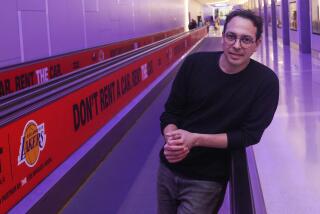Curators strive to make modern art fly at airports
ATLANTA — Travelers often race through airports with barely enough time to check luggage, but the busiest airport in the world invites them to check out something altogether different.
“Mammatus,” the latest art installation at Hartsfield-Jackson Atlanta International Airport, is inspired by mammatocumulus clouds that form in severe storms, swelling into smooth round puffs the artist likens to a woman’s breasts.
Christopher Moulder, an Atlanta-based sculptor, said there was no message to his abstract piece, fashioned out of a metal bead chain into a pendulous ceiling fixture that changes color according to date and time. He noted that people interpreted all kinds of shapes in clouds. “The important thing,” he said, “is that the curves feel good.”
For some, airport art is akin to elevator music: bland and inoffensive. But many airports are expanding their art programs, installing increasingly ambitious works at departure gates, above baggage carousels, along pedestrian walkways — bringing culture to what passes for a public square in modern life.
Nowhere is curating art more challenging than Hartsfield-Jackson, the world’s most frenetic airport, with 90 million travelers passing through its concourses each year. More than 5 million people are expected over the holidays — nearly as many as visit the nation’s busiest museum, the Metropolitan Museum of Art in New York, in an entire year.
As the holiday surge began at the international terminal last week, Kathy Carl, 48, an art teacher from Woodstock, Ga., stopped to contemplate the voluptuous shapes looming above her head.
“It’s gorgeous,” she said. “Very organic, very tranquil.”
Gary Mask, 61, who shuttles passengers to the airport from Alexander City, Ala., said he couldn’t fathom “Mammatus.” “They don’t look like clouds or breasts to me,” he said, adding that the airport should feature more local culture and history. “This is the Peach State, and I don’t see no peaches. There’s nothing letting you know you’ve walked into the middle of Georgia.”
Most passengers, however, were preoccupied with getting from point A to point B. The tedious travel routine of checking in bags and filing through security, of catching shuttles and making connecting flights, did not inspire a contemplative mood.
“We’re exhausted. All we want to do is get out of here,” said Francine Tulloch, 51, an insurance sales associate from Lawrenceville, Ga., who had just returned from her mother’s memorial in Jamaica. The money spent on the sculpture, she suggested, would have been better spent on installing moving sidewalks to help her haul her immense suitcase, carry-on bags and duty-free bottles.
With so many travelers uneasy about flying and so few travelers approaching airports as art destinations, airport curators face logistical and aesthetic challenges. Hartsfield-Jackson, which dedicates 1% of eligible construction budgets to the arts, aims to provide a diversion for travelers who have time, said Katherine Dirga, the airport’s art program manager.
This year, the program has installed more than $5 million of art in its new international terminal, and it’s about to start work on its most expensive project to date: a $4.3-million virtual forest in an underground walkway between concourses.
“We want to make sure their time here is spent pleasantly,” Dirga said. “We definitely don’t want anything disturbing. No politics, no violence, no blood.”
The airport made local headlines this month when it removed an artwork some passengers called disturbing. The painting, “Voter Suppression” by local artist Vincent Sherfield, depicted a shackled man in a prison cell trying to cast a ballot as a guillotine hovered above his head.
Issues of offense can be amplified in the airport setting. Greg Mamary, producer of special projects for the American Assn. of Airport Executives, said many airports started to invest more in art after the terrorist attacks of Sept. 11, 2001, to soothe passengers as they faced greater security screenings and longer wait times. As airport officials look to art to brand host cities and enrich the travel experience, he said, their challenge is to be “sensitive to the audience without compromising what an artist wants to do.”
All too often, aesthetics are trumped by security concerns. Dirga noted that one of Atlanta’s new installations, “Veneers,” a 950-foot series of glass panels showing vivid digital projections of rare wood grains, would have more impact if airport officials dimmed the lights. Similarly, the effect of Moulder’s experiment with shape and light, “Mammatus,” is weakened by its setting in a vast arrival hall next to a wall of windows.
Still, Moulder said he embraced the challenge of creating airport art.
“You’ve got all these people with dead time, and they’re either completely excited or completely exhausted,” he said. “That’s prime time.”
More to Read
Start your day right
Sign up for Essential California for news, features and recommendations from the L.A. Times and beyond in your inbox six days a week.
You may occasionally receive promotional content from the Los Angeles Times.







